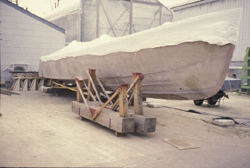New York Sea Grant's
Marina Pollution Prevention Web Site
Section 2: Painting
& Fiberglass Repair
- Fiberglassing
Potential
Environmental Impacts:
The processes involved in fiberglassing, whether using epoxy,
polyester, or vinylester resins for small or big jobs, can have
environmental impacts. Some of the materials used in the fiberglassing
process can be dangerous to workers. Some resins, catalysts and
the solvents used for cleanup can be flammable, irritate the skin
and respiratory system, and may cause cancer.
Best
Management Practices:
Minimize waste by working with small batches of resin.
 Avoid
putting liquid hardener in the trash, since it can spontaneously
combust when mixed with sawdust and other materials.
Avoid
putting liquid hardener in the trash, since it can spontaneously
combust when mixed with sawdust and other materials.
Regulatory
Issues:
Styrene, the primary component of gelcoat and other polyester
resins, is an ignitable chemical. Therefore, cans or containers
of waste resins may be regulated as ignitable hazardous waste
[40 CFR 262.11 click
here]. Certain hardeners and accelerators may also
be regulated as hazardous waste. For more information on New
York hazardous waste testing, management, and storage requirements,
click
here.
Chlorinated
solvents and the rags used to apply them must be managed as hazardous
waste [40 CFR 262.11 click
here]. For more information on New York hazardous
waste management, and storage requirements, click
here. Also see "Rags" fact sheet for
more information, click
here.
If you store
over 10,000 pounds of any hazardous substance requiring an MSDS
(such as a solvent), you must comply with the reporting requirements
under Emergency Planning and Community Right-to-Know Act of 1986
(EPCRA) [40 CFR 355, click
here]. For more information on EPCRA requirements,
click
here.
If you manufacture
hulls or decks for recreational boats made from fiberglass or
aluminum and emit 10 tons or more per year of any one federally
designated hazardous air pollutant (HAP) like styrene, toluene,
or xylene, and/or 25 tons or more per year of all HAPs combined,
several EPA air emission standards must be followed [40 CFR
63, Subpart VVVV, click
here]. Contact New York State Department of Conservation's
Division of Air Resources, Bureau of Stationary Sources at (518)
402-8403 for more information. For information on New York's
air regulations related to marinas, click
here.
If there is
a stormwater discharge from your facility and you perform fiberglassing
outdoors, you may have to register for a General Permit for the
Discharge of Storm Water Associated with Industrial Activity ("Storm
Water General Permit"). For more information on storm
water permitting in New York, click
here.

